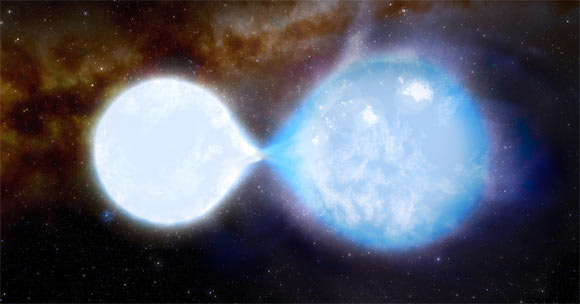SSN 7 is a so-called contact binary located in the Small Magellanic Cloud, a dwarf galaxy some 210,000 light-years away in the constellation of Tucana. Also known as MPG 435, this binary system is a member of the very young stellar cluster NGC 346.

Optical (left) and infrared (right) image of NGC 346 in the Small Magellanic Cloud; the positions of the main ionizing sources of NGC 346, namely SSN 7 and SSN 9, are highlighted by red and green squares, respectively. Image credit: A. Nota, ESA & STScI / NASA / ESA / CSA / O. Jones, UK ATC / G. De Marchi, ESTEC / M. Meixner, USRA / A. Pagan, STScI / N. Habel, USRA / L. Lenkic, USRA / L. Chu, NASA’s Ames Research Center.
The stars in the SSN 7 binary system are in partial contact and swapping material with each other, with one star currently feeding off the other.
They orbit each other every 3 days and are the most massive touching stars (known as contact binaries) yet observed.
Comparing the results of their observations with theoretical models of binary stars’ evolution, they found that, in the best-fit model, the star that is currently being fed on will become a black hole and will feed on its companion star. The surviving star will become a black hole shortly after.
These black holes will form in only a couple of million years, but will then orbit each other for billions of years before colliding with such force that they will generate gravitational waves that could theoretically be detected with instruments on Earth.
“Thanks to gravitational wave detectors Virgo and LIGO, dozens of black hole mergers have been detected in the last few years,” said University College London Ph.D. student Matthew Rickard.
“But so far we have yet to observe stars that are predicted to collapse into black holes of this size and merge in a time scale shorter than or even broadly comparable to the age of the Universe.”
“Our best-fit model suggests these stars will merge as black holes in 18 billion years.”
“Finding stars on this evolutionary pathway so close to our Milky Way Galaxy presents us with an excellent opportunity learn even more about how these black hole binaries form.”
“This binary star is the most massive contact binary observed so far,” added University of Potsdam Ph.D. student Daniel Pauli.
“The smaller, brighter, hotter star, 32 times the mass of the Sun, is currently losing mass to its bigger companion, which has 55 times our Sun’s mass.”

The smaller, brighter, hotter star (left), which is 32 times the mass of our Sun, is currently losing mass to its bigger companion (right), which has 55 times the mass of our Sun. The stars are white and blue as they are so hot: 43,000 K and 38,000 K respectively. Image credit: J. daSilva / University College London.
With the data from several space- and ground-based telescopes, the astronomers were able to calculate the radial velocity of the stars — that is, the movement they made towards or away from us — as well as their masses, brightness, temperature and orbits.
They then matched these parameters with the best-fit evolutionary model.
Their spectroscopic analysis indicated that much of the outer envelope of the smaller star had been stripped away by its larger companion.
They also observed the radius of both stars exceeded their Roche lobe — that is, the region around a star where material is gravitationally bound to that star — confirming that some of the smaller star’s material is overflowing and transferring to the companion star.
“The smaller star will become a black hole first, in as little as 700,000 years, either through a spectacular explosion called a supernova or it may be so massive as to collapse into a black hole with no outward explosion,” Rickard said.
“They will be uneasy neighbors for around 3 million years before the first black hole starts accreting mass from its companion, taking revenge on its companion.”
“After only 200,000 years, an instant in astronomical terms, the companion star will collapse into a black hole as well,” Pauli said.
“These two massive stars will continue to orbit each other, going round and round every few days for billions of years.”
“Slowly they will lose this orbital energy through the emission of gravitational waves until they orbit each other every few seconds, finally merging together in 18 billion years with a huge release of energy through gravitational waves.”
The paper was published online in the journal Astronomy & Astrophysics.
_____
M.J. Rickard & D. Pauli. 2023. A low-metallicity massive contact binary undergoing slow Case A mass transfer: A detailed spectroscopic and orbital analysis of SSN 7 in NGC 346 in the SMC. A&A, in press; doi: 10.1051/0004-6361/202346055







